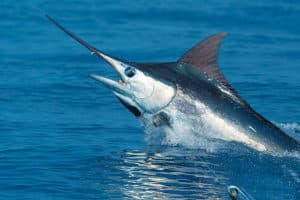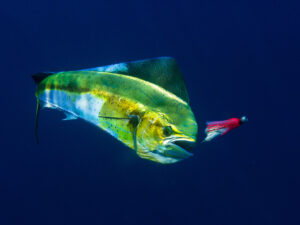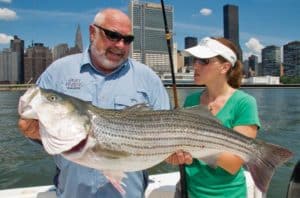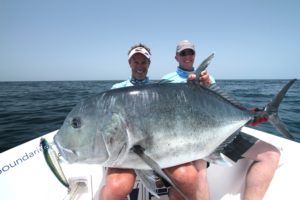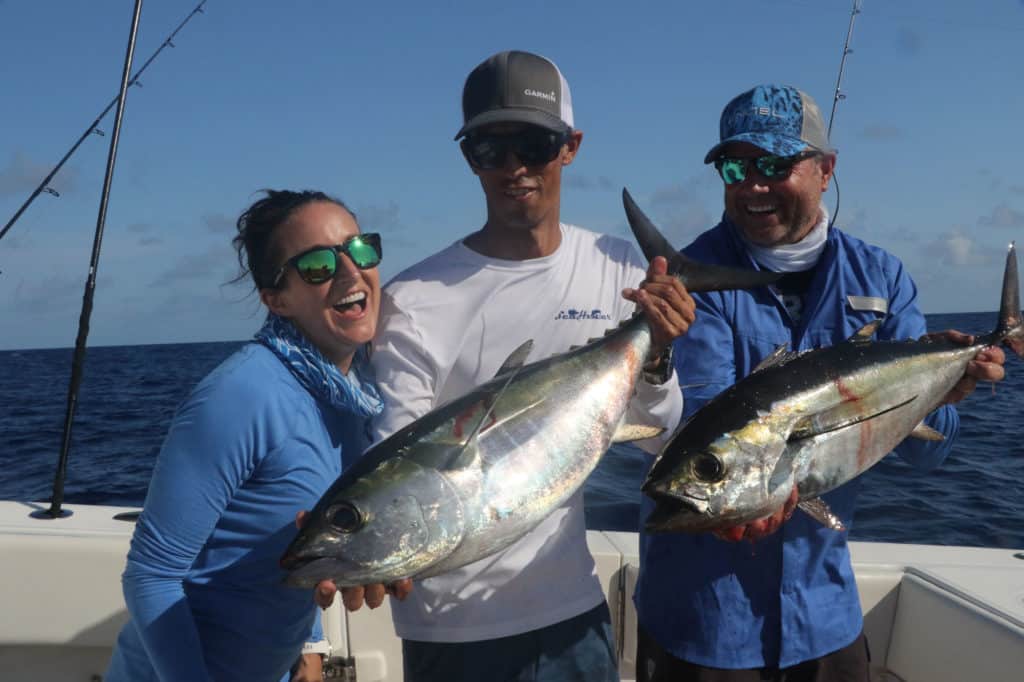
Whereas a free-jumping sailfish is elegant and agile, leaping tuna display far differently, their bullet shapes hurtling out of the water in clean broad jumps across the surface as they pound baitfish. And while free-jumping sails can be notoriously difficult to locate and hook, feeding tuna spell bent rods right now—if anglers can get to them in time.
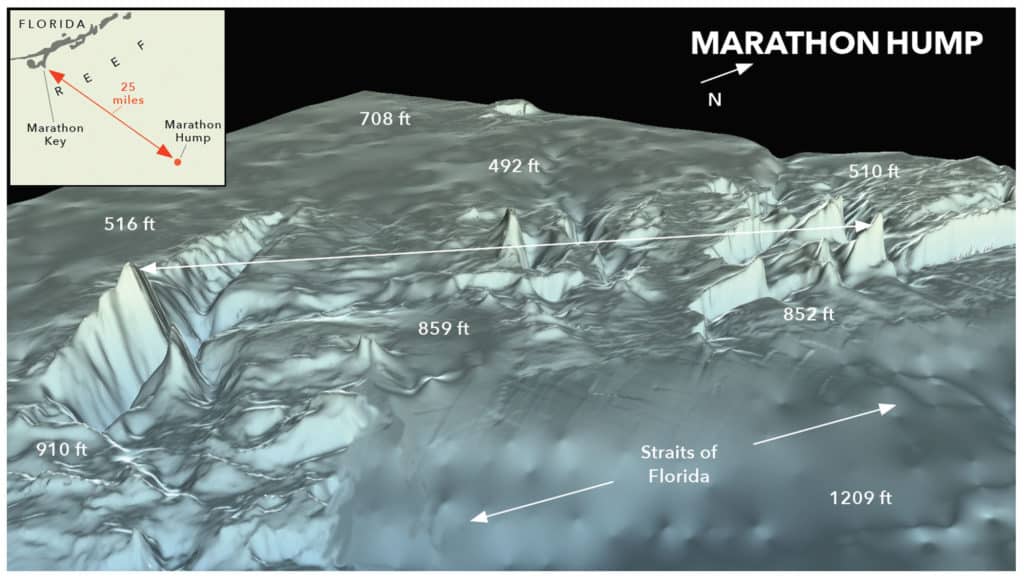
So when Capt. Bernie Perez pointed to the scene on the horizon ahead of his 45-foot SeaHunter early on a May morning, excitement ran high among anglers. There, atop the Marathon Hump—a seamount about 25 miles off Marathon in the Florida Keys that rises from surrounding depths to 500 feet below the surface—we could make out against the rising sun the silhouettes of black shapes leaping from the surface.
“There are your blackfin!” Perez called out. “And they’re not babies!”
The Hump: Productive and Popular
I couldn’t discern their size from a distance, but then I lacked Perez’s experienced eye.
Rather than risk the engines putting down the fish (this spot gets its share of attention from private and charter boats), Perez stopped short and started live-chumming pilchards (scaled sardines) that filled the boat’s baitwells from a stop at a bait receiver after we left the Faro Blanco dock in Marathon. In short order, boils and dark fins slicing the surface announced the presence of tuna, and almost as quickly, anglers began casting out unweighted pilchards pinned to light circle hooks. With little delay, rods began bending and bucking around the stern, and reel spools whirred as large blackfin peeled off line.
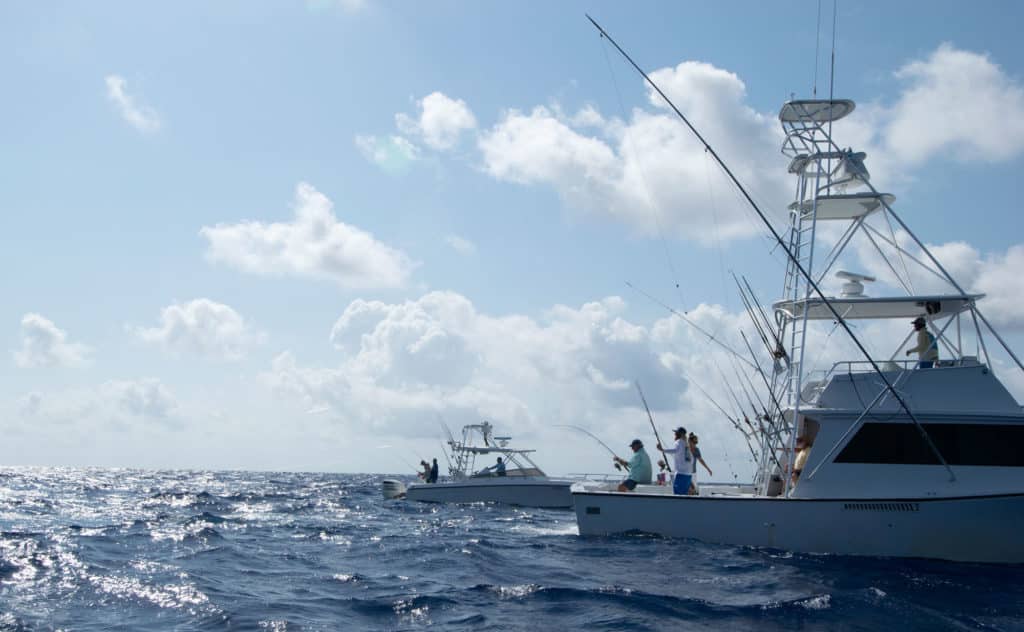
After an exciting hour or so, with some tuna caught and others lost, the fish began to scatter as the sun climbed higher in the sky. “The best times to fish blackfin, without a doubt, are sunup and sundown,” Perez says. He points out that seeing blackfin leaping from the surface first thing in the morning, as we did, is not unusual.
On the other hand, the early-morning bite is hardly a secret, so fairly quickly you might have a bit more company than you’d care for, Capt. Brandon Mullar (broadbillsportfishing.com), out of Duck Key, points out. Sometimes a midday stop, when crowds have thinned, can be productive.
As the day brightened, we had to work a bit more, with the blackfin feeding deeper (Perez mentions their distinctively large and light-sensitive eyes). But the tuna weren’t leaving the hump.
Bonito (little tunny), skipjack and mahi also joined the party that morning, but blackfin dominated. That, Mullar says, is common. “Some days, skipjack will be more prevalent, but normally three-fourths of tuna caught will be blackfin.” Also, he points out, it’s worth keeping in mind that skipjack tend to hunt nearer the surface than blackfin.
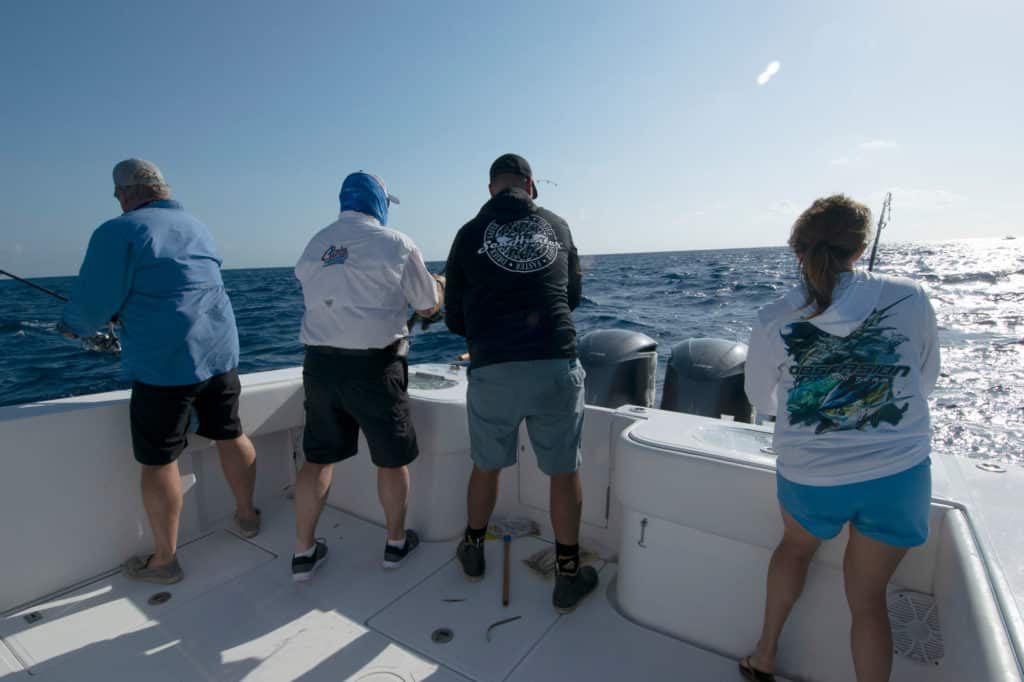
“The hump brings up current from the depths, which is what attracts gamefish to this special place,” Perez says. He points out that just about any and all species of gamefish are likely to be found over the hump at any given time.
“Nutrient-rich upwellings around the pronounced structure of the hump attract juvenile fish and, in turn, larger predators,” adds George Poveromo, host of World of Saltwater Fishing on Discovery, who has been fishing the Keys’ offshore humps since the 1970s. When there’s plenty of current and blue water, there are likely to be plenty of tuna, he says.
Live Baits Hard to Beat
Other structure up and down the lower Keys, such as wrecks and bars, also attract blackfin, despite their lack of high-profile relief compared with seamounts, Poveromo says.
“In fact,” Mullar says, “the popularity of the hump sways many anglers from branching out and trying new areas. Simply plugging in the hump on the GPS and heading there automatically means missing other—and far less crowded—structure where blackfin will congregate, he adds.
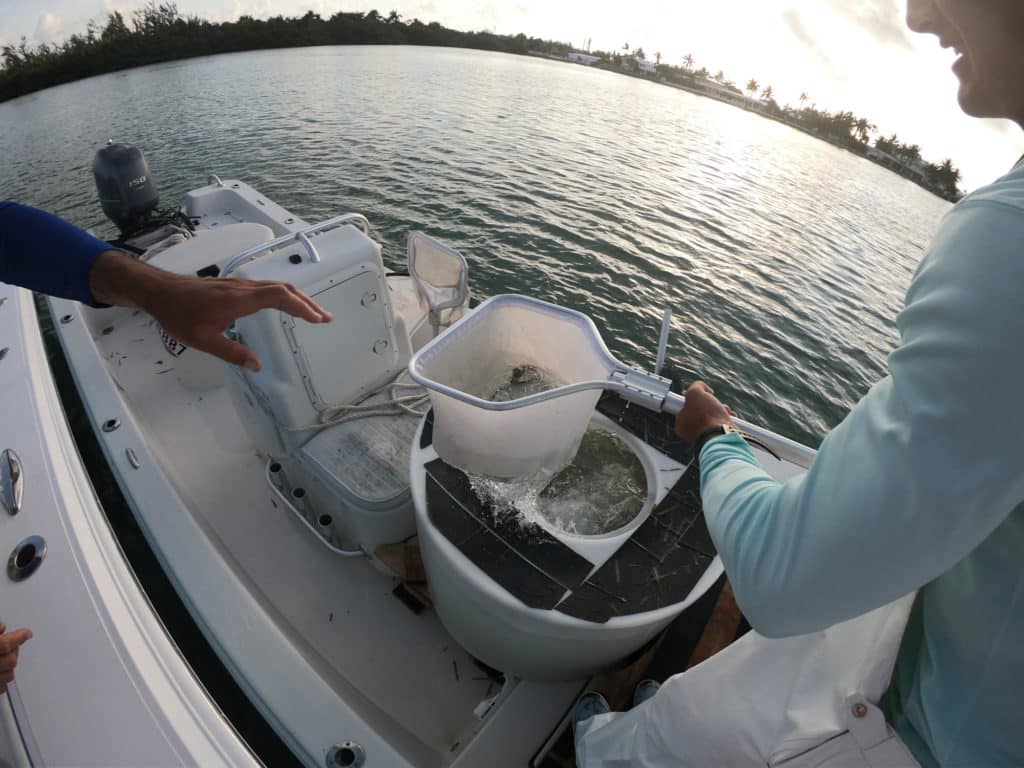
Most of the time, blackfin hunt below the surface, so locating them is a matter of finding them with electronics. “They feed in large schools, and we can mark them on sonar,” Perez says. He keeps an eye on the boat’s Garmin GPSMap 8617, which clearly registers tuna when they’re below the boat.
When he spots the fish schooled up in 200 to 350 feet, Poveromo occasionally drops down metal jigs to them. Jigs do work, agrees Mullar, but he’s less keen on them because of the amount of effort jigging requires—and he believes bigger fish avoid jigs (versus live bait).
On the other hand, Mullar is all about casting poppers when the tuna bust on the surface, if you can get in front of them and shut down before casting.
Blackfin are one of the smaller species among tunas, so tackle can be appropriately light. “I would say that blackfin in the 10- to 20-pound range are a common size for live-baiters,” Perez says.
Poveromo says hump blackfin taken on lures (jigs or trolled feathers and plugs) more likely weigh in the 5- to 8-pound range. (Still, his biggest here was a 32, though he nailed a 42-pounder off Miami Beach.)
“Anything over 20 pounds is a big blackfin,” Perez says. “The biggest I’ve caught have been in the low 30s.”
Rigging Up
On the business end of rigs, Mullar (who cites the keen vision of big-eyed blackfin), Perez and Poveromo all like light fluorocarbon leaders (25- to 30-pound) with light-wire 1/0 to 3/0 circle hooks. Poveromo fishes 20-pound mono main line on Penn Fathom lever-drag reels, sizes 25 and 30, and emulates Marathon’s Capt. Ariel Medero, who ties 40 feet of 30-pound fluoro with a Bimini-twist/Bristol-knot connection.
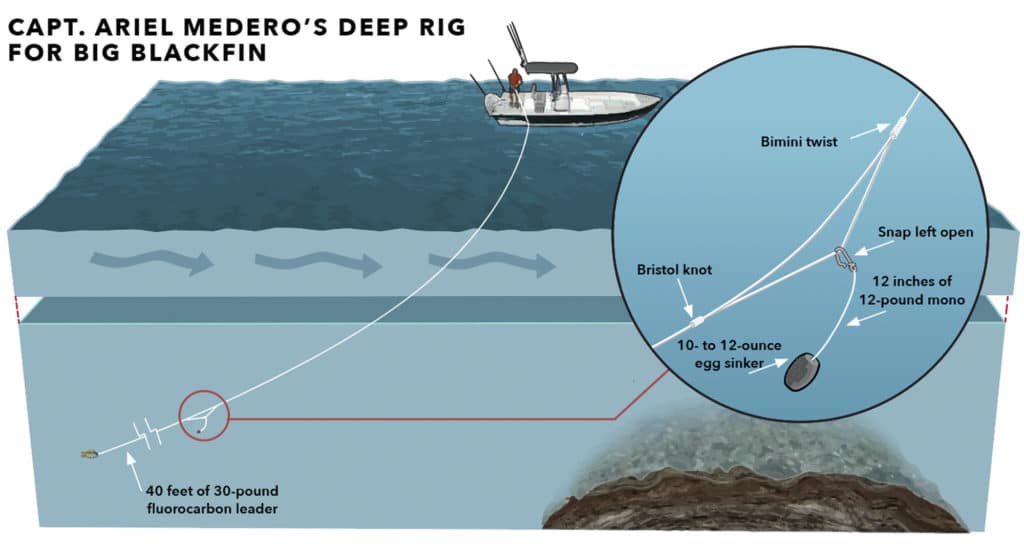
Poveromo points out that one of the advantages his circle hook provides is that, when it latches into the corner of a tuna’s jaw, the leader should remain outside the fish’s mouth and not abrade during the fight. This allows the use of even lighter leaders when that’s warranted.
You can catch blackfin in the lower Keys throughout the year, Mullar says. “Rarely do we strike out when we target them.”
But while they’re available all year, blackfin do tend to peak in fall and early spring, while they’re sparse in winter, Poveromo says. Summer can be good, but hump tuna in the warmer months are likely to run smaller, he adds.
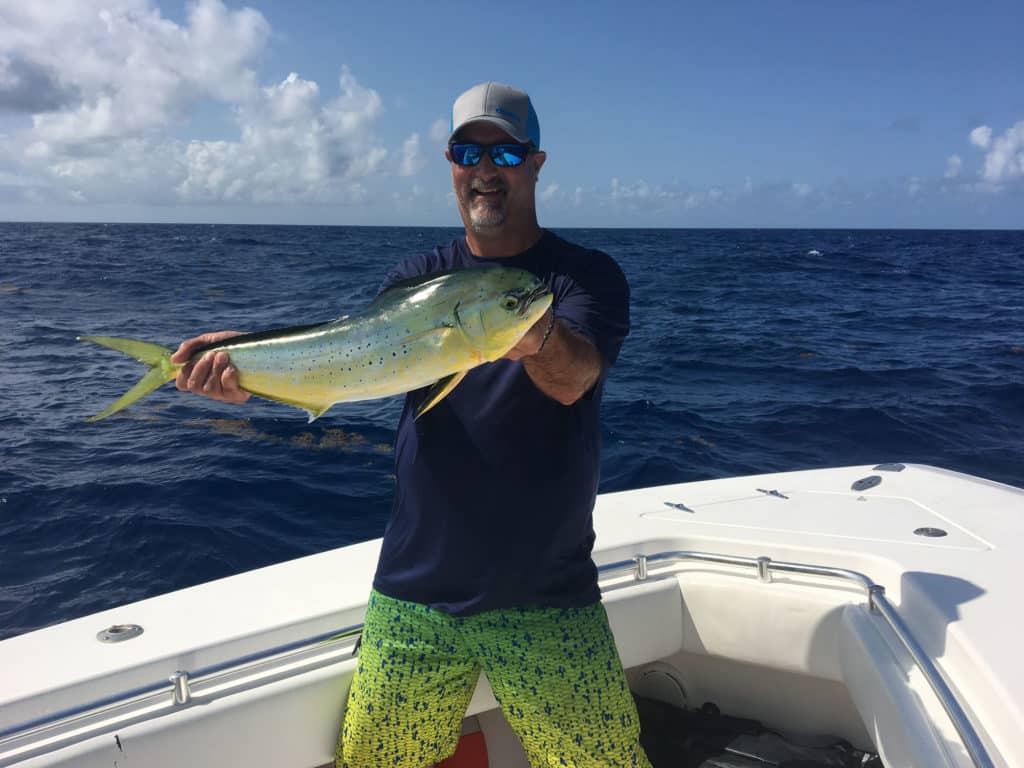
Of course, the Marathon Hump attracts not just blackfin. Mahi often crash the party, Mullar says. Poveromo has caught mahi (some trophy size), sails, wahoo, almaco and amberjack. How about blue marlin? “Last summer on the hump, a blue marlin ate the pinfish my friend had down deep for blackfin. He chased it down and scored a release!”
Blackfin Experts’ Tips
- Fish live bait if possible. “Guys with quality live bait will absolutely smoke those fishing artificials,” says Capt. Brandon Mullar. Capt. Bernie Perez agrees: They’ll hit jigs and feathers, he says, but you can’t beat live-bait chumming, especially for bigger tuna.
- Weighing in with a different but winning strategy, Mullar often passes on live-chumming and puts live baits down 50 to 200 feet—depth depending largely on current.
- Trolling Rapala CD 15 lures can be particularly effective. Rig them on 30-pound fluorocarbon and troll well back—300 to 500 feet—at around 10 knots, Poveromo advises.
- Look for diving pelicans early in the morning on the flats to find pilchards to cast-net for your baitwell, Perez suggests.
- “Although we bridle baits if kite-fishing, when drifting liveys, we run circle hooks up through the bottom jaw and out the top of the bait’s mouth so that it won’t spin back on itself,” Perez says.
- Start at the up-current side of the hump. “Generally speaking, blackfin will stack up there,” Poveromo says. “Often you’ll see boats holding position up-current [of the hump] and live-chumming with pilchards to draw them into feeding frenzies.”
- Once the blackfin respond to live chum, let the boat drift with the current away from the hump while you continue to chum, “taking the fish away from the hungry sharks sometimes sitting on the hump, just waiting,” Perez says.
- Usually abundant pilchards are the go-to live-bait species for chumming, but for deep-drifting liveys, “pinfish rule!” Poveromo says. They survive (and stay lively) when deep-drifted far better than pilchards. (And, oh by the way, the world-record blackfin—just shy of 50 pounds—fell for a pinfish.)
- Mullar says live ballyhoo—which can be caught on the reef’s edge en route offshore—are “fantastic live baits,” but adds that “pretty much any shiny, frisky live fish, including cigar minnows, sardines, goggle-eyes and even white grunts, can be the ticket for blackfin, if presented properly.”
Poveromo advises: Map your drift. Once you’re a half-mile or so down-current of the hump, reel up and follow your plotter track up for another drift if you hit fish; if not, try drifting a different part of the hump.
When dropping baits down, avoid getting deeper than 250 feet “or you’ll end up playing tug of war with a mean amberjack, on light tackle,” Mullar says.
Trolling the hump is often not a best bet when it’s crowded, but “if you must troll,” Mullar says, “be conscious of your turns” and drifting boats. If you pass down-current of the latter, you’re likely to pick up their gear.
Poveromo and Mullar both agree that kites are great—but not so much when there’s a crowd on the hump.
Blackfinology
This small-tuna species is common from the Carolinas south to Brazil, though global warming is likely increasing that range northward. Perhaps because there is no intensive, large-scale-directed commercial fishery, our blackfin stocks appear to be in good shape overall. Still, recognizing the recreational effort this popular coastal tuna engenders, the Florida Fish and Wildlife Commission set new daily limits, effective January 1, 2020, of two fish per person or 10 fish per vessel.
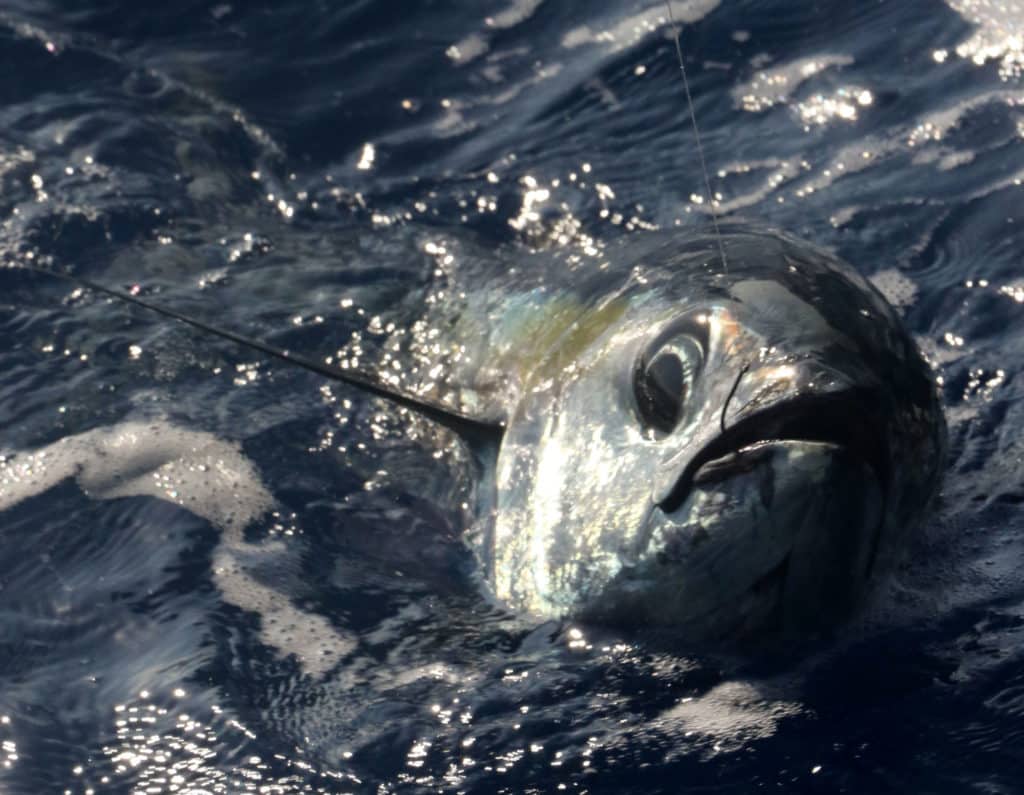
Blackfin can be found anywhere along the continental shelf, but schools are particularly likely to hunt over wrecks, humps and other structure, often associating with (but usually deeper than) little tunny and skipjack.
Read Next: How to Catch Bruiser Blackfin Tuna
The IGFA all-tackle world record, weighing 46 pounds, 9 ounces, came from Marathon in the Florida Keys in April 2006. In fact, the lower Keys dominate line- and tippet-class records for blackfin. Besides being typically strong and fast, as are all tunas, blackfin are valued for their meat. “They’re superb table fare,” Poveromo says, “raw, blackened or grilled.”
Throw Back the Little Ones
“I’ve seen a significant decline of monster blackfins over the years,” Mullar says. “Perhaps 50 boats per day killing trash cans full of baby 2- to 4-pounders has caught up with us. Those same fish in only a few years will yield more fillets than a bucketful of tiny ones. Have some self-control, keep just a few for dinner, then try for a big one.”

